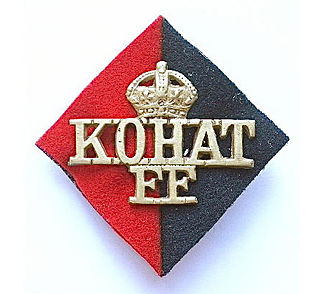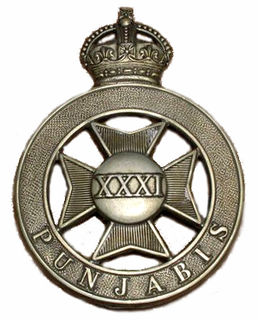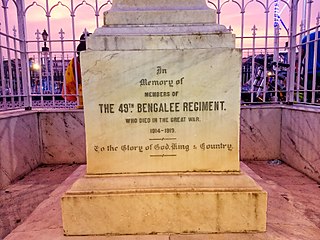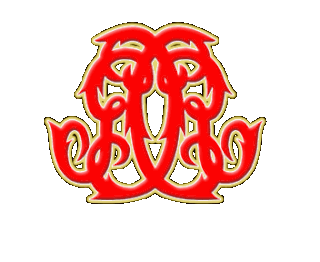 W
WThe 4th Cavalry was a cavalry regiment of the British Indian Army.
 W
WThe 6th Lancers is an armoured regiment of the Pakistan Army. Previously, it was known as the 6th Duke of Connaught's Own Lancers , and was a regular cavalry regiment in the British Indian Army. It was formed in 1921 by amalgamation of the 13th Duke of Connaught's Lancers and the 16th Cavalry. The regiment and its predecessors have seen active service on the North West Frontier, in Egypt during 1882, in China during the Boxer Rebellion, the two World Wars and the Indo-Pakistani War of 1965. On the Partition of India in 1947, the regiment was allotted to the Pakistan Army, where it remains in service today.
 W
WThe Deccan Horse or 9 HORSE is one of the oldest and most decorated armoured regiments of the Indian Army, which was a regular cavalry regiment of the British Indian Army, the Royal Deccan Horse. It was formed from the amalgamation of two regiments after World War I. They saw service from the Mutiny of 1857 up to and including World War II.
 W
WThe 11th Cavalry , is an armoured regiment of the Pakistan Army. It was previously known as the 11th Prince Albert Victor's Own Cavalry and was a regular cavalry regiment of the old British Indian Army. It was formed in 1921 by the amalgamation of the 21st Prince Albert Victor’s Own Cavalry and the 23rd Cavalry.
 W
WThe 11 Gorkha Rifles is a Gorkha regiment of the Indian Army that was re-raised after independence. The regiment consists of primarily the Kirati Tribes Rai and Limbu of Nepal and north-eastern India. It also recruits from Indian Gorkhas and Bhutias from Darjeeling district, West Bengal and Sikkim. Though it is considered to be the youngest of the Gorkha regiments its lineage is as long as those of the 7th Gurkha Rifles and 10th Gurkha Rifles.
 W
WThe 14th Prince of Wales's Own Scinde Horse was a regular cavalry regiment of the Bombay Army, and later British Indian Army, it can trace its formation back to The Scinde Irregular Horse raised at Hyderabad on 8 August 1838. It was named after the province of Sind now in Pakistan, where it was raised to protect the trade route from the Bolan Pass to Sukkur on the Indus River and fight against the marauding Baluchi warriors. It later expanded to the 1st, 2nd and 3rd Scinde Horse. These three regiments were absorbed into the regular forces after the Mutiny of 1857 and became the 35th Scinde Horse and the 36th Jacob's Horse. They saw active service in Northern and Central India, Persia, Afghanistan on the North West Frontier and, during World War I, where they served in France and Palestine. The two regiments were amalgamated in 1922, as the present 14th Prince of Wales's Own Scinde Horse which served in World War II. Scinde Horse is the only regiment known to honour its enemy till date and has not changed its badge since its raising, unlike others who have done so-numerous times. At one point, the regiment carried 9 Standards while on parade, a unique privilege given to it for its valor. The regiment was the first Cavalry unit in the British Indian Army to get mechanized in the Indian sub-continent at Rawalpindi, in 1938. It was also the first Cavalry regiment to get the President of India's Standard post independence.
 W
WThe 16th Light Cavalry is a regiment of the Armoured Corps, a primary combat arm of the Indian Army. Prior to India gaining independence from the British in 1947, it was a regular cavalry regiment of the British Indian Army. It was formed in 1776 and is the oldest armoured regiment raised in India. The 16th Light Cavalry saw service in a number of conflicts ranging from the Second Anglo-Mysore War in 1781 to World War II. It has a number of battle honours including "Punjab 1965" earned during the Indo-Pakistani War of 1965.
 W
WThe 21st Kohat Mountain Battery was an artillery unit of the British Indian Army. It was raised in 1851 as the No. 2 Horse or Punjab Light Field Battery, Punjab Irregular Force. It became the 21st Kohat Mountain Battery in 1903. In 1947, it was transferred to the Pakistan Army, where it exists as the 2nd Royal Kohat Battery of The First (SP) Medium Regiment Artillery.
 W
WThe 24th Hazara Mountain Battery was an artillery battery of the British Indian Army. The battery was raised in 1851, at Haripur in order to help defend the Hazara District of the North West Frontier. The 4th soon saw action in numerous small campaigns on the North West Frontier. In 1878, the 4th took part in the Second Afghan War at the Battle of Ali Masjid, and later took part in the Siege of the Sherpur Cantonment, where it remained as part of the garrison when the rest of the force marched on Kandahar. In 1885, the Battery took part in the Second Burmese War. It was at Hunza during the campaign in 1891. In 1895, the Battery was back fighting on the Frontier as part of the Chitral Expedition.To honour the visit of the Prince and Princess of Wales to Indian they took part in the Rawalpindi Parade 1905. During World War I, the 4th left India in 1917, for East Africa where it would remain until the Armistice. Between the wars, the Battery saw service in the Third Afghan War of 1919, the Afridi and Red Shirt Rebellion (1930–1), the Mohmand and Bajaur Operations (1933), and operations against the Fakir of Ipi in the Waziristan campaign 1936–1939. It was deployed to Singapore at the opening of World War II, and entered Japanese captivity with the rest of the garrison.
 W
WThe 24th Punjabis were an infantry regiment of the British Indian Army. It was raised in 1857, as the 11th Regiment of Punjab Infantry. It was designated as the 24th Punjabis in 1861 and became 4th Battalion 14th Punjab Regiment in 1922. In 1947, it was allocated to the Pakistan Army, where it continues to exist as 8th Battalion The Punjab Regiment.
 W
WThe 30th Punjabis were an infantry regiment of the British Indian Army. It was raised in 1857, as the 22nd Regiment of Punjab Infantry. It was designated as the 30th Punjabis in 1903 and became 1st Battalion 16th Punjab Regiment in 1922. In 1947, it was allocated to the Pakistan Army, where it continues to exist as 13th Battalion The Punjab Regiment.
 W
WThe 31st Punjabis was an infantry regiment of the British Indian Army. It was raised in 1857, as Van Cortlandt's Levy. The regiment was designated as the 31st Punjabis in 1903 and became 2nd Battalion 16th Punjab Regiment in 1922. In 1947, it was allocated to the Pakistan Army, where it continues to exist as 14th Battalion The Punjab Regiment.
 W
WThe 33rd Punjabis was an infantry regiment of the British Indian Army. It was raised in 1857, as the Allahabad Levy. It was designated as the 33rd Punjabis in 1903 and became 3rd Battalion 16th Punjab Regiment in 1922. In 1947, it was allocated to the Pakistan Army, where it continues to exist as 15th Battalion The Punjab Regiment.
 W
WThe 84th Punjabis was an infantry regiment of the British Indian Army. It was raised by Captain Donald Macdonald at Vellore on 12 August 1794, as the 34th Battalion of Madras Native Infantry. It was designated as the 84th Punjabis in 1903 and became the 10th (Training) Battalion, 1st Punjab Regiment in 1922. In 1943, it was converted into the 1st Punjab Regimental Centre. In 1947, the 1st Punjab Regiment was allocated to the Pakistan Army. In 1956, the 1st, 14th, 15th and 16th Punjab Regimental Centres where amalgamated to form the Punjab Regimental Centre.
 W
WThe 89th Punjabis was an infantry regiment of the British Indian Army raised in 1798 as a battalion of Madras Native Infantry. It was designated as the 89th Punjabis in 1903 and became 1st Battalion 8th Punjab Regiment in 1922. In 1947, it was allocated to Pakistan Army, where it continues to exist as 1st Battalion, The Baloch Regiment.
 W
WThe 90th Punjabis were an infantry regiment of the British Indian Army. The regiment was raised in 1799 as a battalion of Madras Native Infantry. It was designated as the 90th Punjabis in 1903 and became 2nd Battalion 8th Punjab Regiment in 1922. In 1947, it was allocated to Pakistan Army, where it continues to exist as 2nd Battalion of The Baloch Regiment.
 W
WThe 91st Punjabis was an infantry regiment of the British Indian Army. The regiment was raised in 1800 as a battalion of Madras Native Infantry. It was designated as the 91st Punjabis in 1903 and became 3rd Battalion 8th Punjab Regiment in 1922. In 1947, it was allocated to Pakistan Army, where it continues to exist as 3rd Battalion of The Baloch Regiment.
 W
WThe 92nd Punjabis were an infantry regiment of the British Indian Army. The regiment was raised in 1800 as a battalion of Madras Native Infantry. It was designated as the 92nd Punjabis in 1903 and became 4th Battalion 8th Punjab Regiment in 1922. In 1947, it was allocated to Pakistan Army, where it continues to exist as 4th Battalion of The Baloch Regiment.
 W
WThe 93rd Burma Infantry was an infantry regiment of the British Indian Army. The regiment was raised in 1800 as a battalion of Madras Native Infantry. It was designated as the 93rd Burma Infantry in 1903 and became the 5th (Burma) Battalion 8th Punjab Regiment in 1922. In 1947, it was allocated to the Pakistan Army, where it continues to exist as 5th Battalion of The Baloch Regiment.
 W
WThe Assam Rifles is the oldest paramilitary force of India. The unit can trace its lineage back to a paramilitary police force that was formed under the British in 1835 called Cachar Levy. Since then the Assam Rifles have undergone a number of name changes—the Assam Frontier Police (1883), the Assam Military Police (1891) and Eastern Bengal and Assam Military Police (1913), before finally becoming the Assam Rifles in 1917. Over the course of its history, the Assam Rifles and its predecessor units have served in a number of roles, conflicts and theatres including World War I where they served in Europe and the Middle East, and World War II where they served mainly in Burma. In the post World War II period the Assam Rifles has expanded greatly as has its role. There are currently 46 battalions of Assam Rifles with a sanctioned strength of 63,747 personnel.
 W
WThe Bengal Engineer Group (BEG) is a military engineering regiment in the Corps of Engineers of the Indian Army. The unit was originally part of the Bengal Army of the East India Company's Bengal Presidency, and subsequently part of the British Indian Army during the British Raj. The Bengal Sappers are stationed at Roorkee Cantonment in Roorkee, Uttarakhand.
 W
WBangali Platoon or Bengalee Regiment was a regiment of Bengali soldiers raised during the First World War with Lt. S. G. Taylor as a Regiment Commander. At the beginning of the First World War (1914-1918). So that time many non-combatant soldiers and skilled and unskilled laborers were also recruited from Bengal. In middle 1916, the British Government decided to create a regiment of Bengali soldiers. At first, it was called Bengali Double Company. These Double Companies, each consisting of 228 soldiers, are thought to annex with Indian Army as a regiment. The Bengali Double Company raised the first Bengali Battalion on 26 June 1917. It was named the 49th Bengalee regiment or briefly the 49th Bengalee. It was disbanded in 1920.
 W
WThe Central India Horse was a regular cavalry regiment of the British Indian Army. They were formed at the start of the Indian Rebellion of 1857 and served in the Great War and the Second World War.
 W
WThe Corps of Guides was a regiment of the British Indian Army made up of British officers and Indian enlisted soldiers to serve on the North West Frontier. As originally raised in 1846, The Guides consisted of infantry and cavalry. It evolved through the 20th century to become the Guides Cavalry and Guides Infantry. Once independence was granted to India and after the partition, The Guides were given over to Pakistan and became part of the Pakistan Army with all ranks including officers being recruited solely from Pakistan.
 W
WThe Governor General's Bodyguard was a cavalry regiment of the British Indian Army. The regiment was, in effect, the Indian equivalent of the Household Cavalry of the British Army.
 W
WThe Grenadiers is an infantry regiment of the Indian Army, formerly part of the Bombay Army and later the pre-independence British Indian Army, when the regiment was known as the 4th Bombay Grenadiers. It has distinguished itself during the two world wars and also since the Independence of India. The regiment has won many battle honours and gallantry awards, and is considered to be one of India's most decorated regiments with three Param Vir Chakra awardees in three different conflicts.
 W
WThe Guides Cavalry is an armoured regiment of the Pakistan Army which was raised in 1846 as The Corps of Guides. During more than a hundred and fifty years of military service, the regiment has earned the reputation of one of the most renowned military units in the world.
 W
WThe Guides Infantry, or 2nd Battalion (Guides) The Frontier Force Regiment, is an infantry battalion of the Pakistan Army. It was raised in 1846 as part of the famous Corps of Guides.
 W
WThe Kumaon Regiment is the most decorated infantry regiment of the Indian Army. The regiment traces its origins to the 18th century and has fought in every major campaign of the British Indian Army and the Indian Army, including the two world wars.
 W
WMadras Engineer Group (MEG), informally known as the Madras Sappers, is an engineer group of the Corps of Engineers of the Indian Army. The Madras Sappers draw their origin from the erstwhile Madras Presidency army of the British Raj. This regiment has its HQ in Bengaluru. The Madras Sappers are the oldest of the three groups of the Corps of Engineers.
 W
WMultan Regiment was a regiment of the British Indian Army that saw action in the Battle of Ghazni, during the First Afghan War in 1839. The regiment was based in the city of Multan where it was first raised. Since the independence of Pakistan in 1947, it has been part of the Pakistan Army.